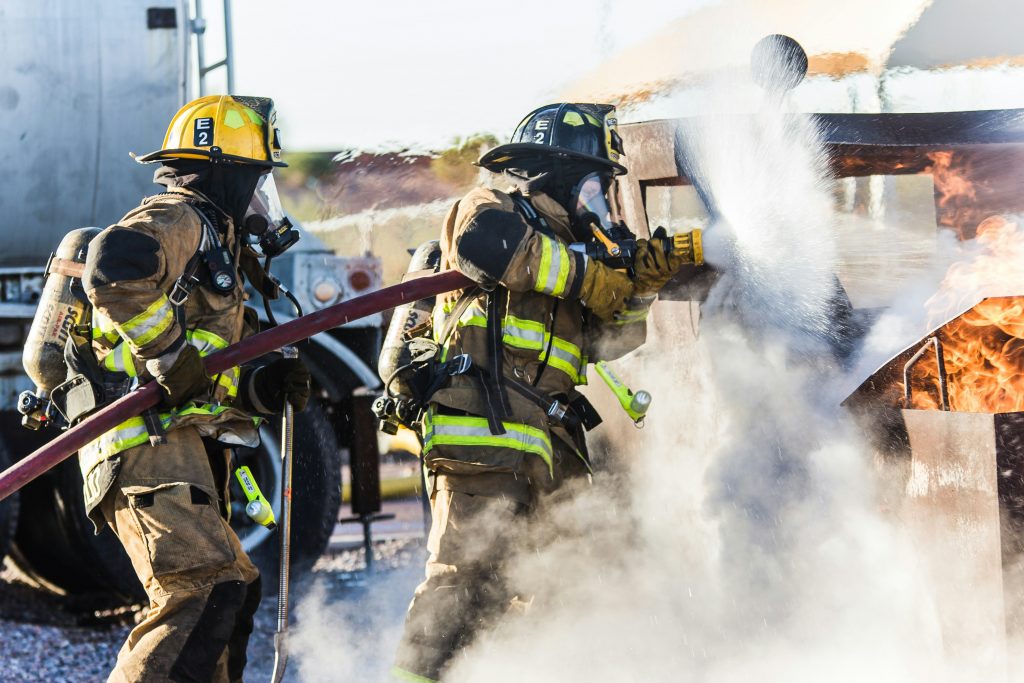
First Responders (FRs), such as law enforcement officers (LEOs), firefighters (FFs), and emergency medical technicians (EMTs) are frequently exposed to traumatic events as part of their job. As a result, individuals with these jobs often disproportionately present with symptoms of depression, generalised anxiety disorder (GAD) and post-traumatic stress disorder (PTSD) compared to the general population, and are at increased risk of suicide (Tiesman et al., 2021; Walker et al., 2016).
Untangling the co-occurrence of these three mental health conditions is of key importance for both clinical and non-clinical researchers, as it can make accurate diagnosis and subsequent treatment difficult, leading to underdiagnosis. Although transdiagnostic approaches have significantly improved our understanding and treatment outcomes (to learn more about transdiagnostic approaches to mental health, read Melissa and Tim’s 2019 Mental Elf blog here, or Isabeau’s 2023 blog here), the connections between the symptoms of these overlapping disorders remains unclear, alongside whether commonalities extend to underlying mechanisms beyond negative affectivity, as proposed by the tripartite model (Clark & Watson, 1991). Understanding these connections is crucial because it will shed light on the shared and the unique characteristics of each disorder, contributing to more precise diagnosis and more effective treatments.
To that end, Baker et al. (2023) explored this research gap by using network analysis to identify patterns of symptoms within PTSD, depression, and GAD among FRs. Network analysis is a method that helps researchers create a map of symptoms to see how they connect and influence each other, with symptoms being dots on the map, and lines between them showing how strongly they are related.

As First Responders suffer disproportionately from PTSD, depression and anxiety, understanding symptom connections can help unveil intertwined patterns and mechanisms.
Methods
Data were collected from 432 US first responders (FRs) seeking treatment (42.4% law enforcement officers (LEOs), 20.1% firefighters (FFs), and 22.5% emergency medical technicians (EMTs), most of whom identified as male (72.7%) and White (78.9%), with an average age of 37.6 years and 12.2 years of experience in their roles. Data was collected between 2015 and 2021 from a nonprofit organisation with the following measures:
- PTSD Checklist-5 (PCL-5) for post-traumatic stress symptoms, with scores >41 indicating probable PTSD
- Patient Health Questionnaire-9 (PHQ-9) for depressive symptoms
- Generalized Anxiety Disorder-7 (GAD-7) questionnaire for GAD
Network analysis was used to examine the relationships between symptoms of PTSD, depression, and GAD, which allowed the researchers to create a map of connections between symptoms. This type of analysis was used to help the researchers understand which symptoms tend to occur together and which ones trigger other symptoms, thus giving a depiction of the overlap between PTSD, depression and GAD symptoms. R software was used employing the Gaussian Graphic Model to calculate connections between symptoms as partial correlations. Common symptoms across the three disorders were removed so that each symptom appeared only one time in the network. Community detection analysis was conducted to identify groups of symptoms that are better connected to each other.
Results
Nearly 40% of participants reported symptoms that met the cutoff score (>41) for probable PTSD, whereas 16.5% met the scores for severe depression and 35% for severe GAD.
Network analysis
Six communities of symptoms were identified through the network analysis. Although depression and GAD symptoms largely clustered into their own unique groups, PTSD symptoms clustered into four separate groups:
- Intrusion and avoidance
- Arousal and sleep
- Negative affect
- Irritability and aggression (which also included the GAD symptom “feeling easily annoyed”)
The strongest connections between symptoms within diagnostic categories were:
- Nervous – Worry About Many Things (r = 0.57; GAD)
- Avoid Thoughts – Avoid Reminders (r = 0.54; PTSD)
- Hypervigilance – Startle Response (r = 0.51; PTSD)
- Detachment – Restricted Affect (r = 0.36; PTSD)
- Blame of Self or Others – Negative Emotion (r = 0.34; PTSD)
- Intrusive Thoughts – Nightmares (r = 0.32; PTSD)
- Concentration – Psychomotor Agitation/Retardation (r = 0.30; depression)
The strongest connections between symptoms across diagnostic categories were:
- Irritable Behaviour – Easily Annoyed (r = 0.41)
- Negative Belief – Worthlessness (r = 0.20)
- Reckless Behaviour – Suicide Ideation (r = 0.16)
- Fear of Awful Things – Worthlessness (r = 0.15)
- Unable to relax – Low Energy (r = 0.13)
- Sleep Disturbance – Low Energy (r = 0.13)
- Unable to Relax – Anhedonia (r = 0.12)
The network analysis also revealed that feeling unable to relax (GAD) and intrusive thoughts (PTSD) were the symptoms that, if triggered, would be more likely to increase other symptoms. Other less central symptoms included negative emotion, detachment, uncontrollable worry, avoidance of reminders and depressed mood.

Network analysis revealed that between the diagnostic categories, key symptoms like irritability (PTSD) and feeling easily annoyed (GAD) showed the strongest correlation among First Responders, followed by negative beliefs (PTSD) and feelings of worthlessness (depression).
Conclusions
This network analysis by Baker et al. (2023) supports the complex interplay between symptoms within and across PTSD, depression, and anxiety in first responders, emphasising the need for tailored, transdiagnostic interventions that are able to address key symptoms like feeling unable to relax and intrusive thoughts.

The findings from this network analysis highlight the need for tailored interventions addressing key symptoms experienced by First Responders, such as feeling unable to relax and experiencing intrusive thoughts.
Strengths and limitations
While the detrimental impact of frequent exposure to trauma is well-documented, the in-depth exploration of PTSD, GAD and depression in FRs is lacking in research; thus, this study provides guidance for future research taking a symptoms-based approach to FRs’ mental health. Overall, the use of a network analysis allows researchers and practitioners to think beyond diagnostic categories and disorder labels. The findings highlight the interrelated nature of mental health symptoms beyond diagnostic categories, whereby symptoms with larger influence can contribute to triggering or maintaining other symptoms. This is a strength because it can help identify potentially influential symptoms that have the strongest impact on a range of other symptoms in the same, but also across different diagnostic categories. Moreover, by excluding questions on symptoms that are common across multiple disorders (e.g., questions on sleep disturbances appear in both PTSD and depression questionnaires), the analysis was able to more accurately identify and understand the truly shared and central symptoms. Finally, the researchers used validated standardised measures and a clinically relevant sample consisting of treatment seeking FRs, which increases the trustworthiness of the findings and its potential to generalise to the real world.
However, the use of self-reported assessments rather than clinical diagnostic interviews may have introduced potential biases in symptom reporting. For example, individuals might overestimate or underestimate the severity of their symptoms due to personal perceptions or recall bias. Additionally, the researchers acknowledge that the study’s focus on FRs seeking mental health treatment may overlook individuals who experience significant distress but do not seek professional help, as is the case for a larger proportion of FRs (Chalmers & Jeffrey, 2023). As the study is cross-sectional, it also does not provide any insights into how stable the symptom groups and connections are over time and whether these are sensitive to the most recent traumatic event FRs have experienced. Further, it was interesting that the study did not explore potential differences in symptom networks between the subgroups of FRs, which may have demonstrated distinct symptom presentations and subsequently different treatment needs.
Limitations in the ability to generalise the study findings may also stem from the use of a model that assumes normally distributed data, as negative psychological variables are usually skewed. As replicability is often a significant challenge for network analysis studies, future replication studies are needed to explore the reliability of the results across different samples and populations.

Whilst this network analysis addresses an important and practically relevant topic, there are limitations to its approach, including reliance on self-report assessments, cross-sectional data, and the lack of subgroup analyses.
Implications for practice
Practice
- The recognition of shared underlying factors across PTSD, GAD and depression highlights the utility of transdiagnostic approached to treatment, such as the Unified Protocol, whereby practitioners implement sessions focusing on the common underlying factors that contribute to these disorders (e.g., using emotion regulation techniques that address irritability and feeling easily annoyed).
- By identifying connections between different symptoms, practitioners can implement targeted techniques that are able to address the most transdiagnostically influential symptoms, which may help to improve treatment outcomes in FRs.
- Identifying connections across diagnostic categories can help with the identification of early signs of poor mental health in FRs, which could enable early interventions that will prevent progression of symptoms, with benefits for long-term mental health outcomes.
Policy
- Including a routine comprehensive assessment of symptoms related to PTSD, depression, and GAD for FRs could help take advantage of early identification and promote prevention. This early intervention can help mitigate the accumulation of distress over time, thereby reducing the severity and impact of these mental health issues on first responders.
- Support for FRs needs to be based on multimodal treatment planning, combining psychotherapy and adjunctive interventions (e.g., exercise-based therapy, pharmacotherapy), alongside recognising that brief counselling sessions as a “tick box” exercise are not sufficient.
- Policymakers should encourage the integration of symptom-based approaches into mental health services for FRs, to offer interventions that can be more personalised and targeted, leading to better outcomes for mental health treatment.
Research
- Further studies are needed to understand whether the symptom networks identified here can replicate across different FR samples, and how these compare to different populations.
- Research that can track changes in symptom networks over time among FRs will enhance our understanding of the dynamics of symptom interplay and allow inferences for the directions of symptom connections.
- Future research should explore if the frequency of exposure to trauma is a relevant parameter and whether it could explain some of the interrelations identified between PTSD, GAD and depression symptoms.

Policymakers should prioritise comprehensive assessments and multimodal treatments to enhance prevention and provide personalised, symptom-based mental health support for first responders, leading to better outcomes and reduced cumulative distress.
Statement of interests
I have no competing interests to declare.
Links
Primary paper
Baker, L. D., Ponder, W. N., Carbajal, J., Galusha, J. M., Hidalgo, J. E., & Price, M. (2023). Mapping PTSD, depression, and anxiety: a network analysis of co-occurring symptoms in treatment-seeking first responders. Journal of Psychiatric Research, 168, 176-183.
Other references
Black, M., & Dalgleish, T. (2019). Transdiagnostic approaches to mental health: Keeping the baby and throwing out the bathwater. The Mental Elf.
Chalmers, R.J. & Jeffrey, A.L. (2023). Mental Health of First Responders. Journal of Emergency Medical Services.
Clark, L. A., & Watson, D. (1991). Tripartite model of anxiety and depression: psychometric evidence and taxonomic implications. Journal of Abnormal Psychology, 100(3), 316.
Tiesman, H.M., Elkins, K.L, Brown, M., Marsh, E., & Carson, E. (April, 6, 2021). Suicides Among First Responders: A Call to Action. https://blogs.cdc.gov/niosh-science-blog/2021/04/06/suicides-first-responders/
Tindall, I. (2023). Are transdiagnostic mental health interventions the future of treatment? The Mental Elf.
Walker, A., McKune, A., Ferguson, S., Pyne, D. B., & Rattray, B. (2016). Chronic occupational exposures can influence the rate of PTSD and depressive disorders in first responders and military personnel. Extreme Physiology & Medicine, 5, 1-12.
Photo credits
- Photo by Aidan Bartos on Unsplash
- Photo by Alina Grubnyak on Unsplash
- Photo by Andre Hunter on Unsplash
- Photo by Matt C on Unsplash
- Photo by ODISSEI on Unsplash
- Photo by Scott Rodgerson on Unsplash
